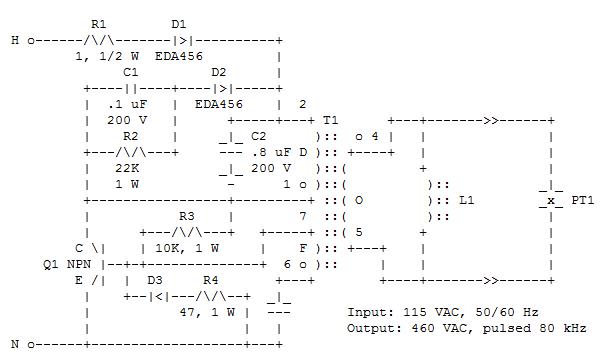Jedna jednostavna sema sto sam izgooglao (doduse 110V in):
Ultrasonic Cleaner
Ultrasonic cleaning is a means of removing dirt and surface contamination from intricate and/or delicate parts using powerful high frequency sound waves in a liquid (water/detergent/solvent) bath.
An ultrasonic cleaner contains a power oscillator driving a large piezoelectric transducer under the cleaning tank. Depending on capacity, these can be quite massive.
A typical circuit is shown below. This is from a Branson Model 41-4000 which is typical of a small consumer grade unit. The H and N are Hot and Neutral of the 115 VAC line. WARNING: Line connected input. Use isolation transformer for safety when troubleshooting.
The power transistor (Q1) and its associated components form an self excited driver for the piezo-transducer (PT1). I do not have specs on Q1 but based on the circuit, it probably has a Vceo rating of at least 500 V and power rating of at least 50 W.
Two windings on the transformer (T1, which is wound on a toroidal ferrite core) provide drive (D) and feedback (F) respectively. L1 along with the inherent capacitance of PT1 tunes the output circuit for maximum amplitude.
The output of this (and similar units) are bursts of high frequency (10s to 100s of kHz) acoustic waves at a 60 Hz repetition rate. The characteristic sound these ultrasonic cleaners make during operation is due to the effects of the bursts occuring at 60 Hz since you cannot actually hear the ultrasonic frequencies they use.
The frequency of the ultrasound is approximately 80 kHz for this unit with a maximum amplitude of about 460 VAC RMS (1,300 V p-p) for a 115 VAC input.
WARNING: Do not run the device with an empty tank since it expects to have a proper load. Do not touch the bottom of the tank and avoid putting your paws into the cleaning solution while the power is on. I don't know what, if any, long term effects there may be but it isn't worth taking chances. The effects definitely feel strange. At high enough power levels, it could indeed pulverize bones as described below. Whether that could happen with the typical small ultrasonic cleaner, I don't know and am not about to find out!
(From: BIll Perry (
[email protected]).)
"While stationed on board the now-decommissioned submarine USS Hawkbill (SSN-666), I pondered this as well. One of my senior shipmates related a story of a sailor who had done that very act on his previous submarine. The guy put his feet it the cleaner while it was powered on. He remarked that it felt very good and relaxing. After a few minutes, he pulled his feet out, and as soon as he stood up and applied his full bodily weight on his feet, all the bones in his feet had shattered. He got permanent disability from it. Apparently, it had rattled his bones apart. Wow!"
Where the device doesn't oscillate (it appears as dead as a door-nail), first check for obvious failures such as bad connections and cracked, scorched, or obliterated parts.
To get inside probably requires removing the bottom cover (after pulling the plug and disposing of the cleaning solution!).
CAUTION: Confirm that all large capacitors are discharged before touching anything inside!
The semiconductors (Q1, D1, D2, D3) can be tested for shorts with a multimeter (see the document: Basic Testing of Semiconductor Devices.
The transformer (T1) or inductor (L1) could have internal short circuits preventing proper operation and/or blowing other parts due to excessive load but this isn't kind of failure likely as you might think. However, where all the other parts test good but the cleaning action appears weak without any overheating, a L1 could be defective (open or other bad connections) detuning the output circuit.
Where the transistor and/or fuse has blown, look for a visible burn mark on the transducer and/or test it (after disconnecting) with a multimeter. If there is a mark or your test shows anything less than infinite resistance, there may have been punch-through of the dielectric between the two plates. I don't know whether this could be caused by running the unit with nothing in the tank but it might be possible. If the damage is localized, you may be able to isolate the area of the hole by removing the metal electrode layer surrounding it to provide an insulating region 1/4 inch in diameter. This will change the resonant frequency of the output circuit a small amount but hopefully not enough to matter. You have nothing to lose since replacing the transducer is likely not worth it (and perhaps not even possible since it is probably solidly bonded to the bottom of the tank).
When testing, use a series light bulb to prevent the power transistor from blowing should there be a short circuit somewhere (see the document: Troubleshooting and Repair of Consumer Electronic Equipment) AND do not run the unit with and empty tank.
Also see the info on ultraonic humidifiers in the document: Troubleshooting and Repair of Small Household Appliances.
Ultrasonic tranducers:
http://www.steminc.com/

Sinisa